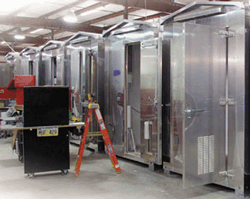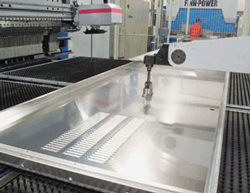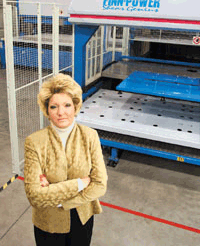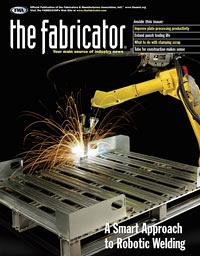Contributing Writer
- FMA
- The Fabricator
- FABTECH
- Canadian Metalworking
Categories
- Additive Manufacturing
- Aluminum Welding
- Arc Welding
- Assembly and Joining
- Automation and Robotics
- Bending and Forming
- Consumables
- Cutting and Weld Prep
- Electric Vehicles
- En Español
- Finishing
- Hydroforming
- Laser Cutting
- Laser Welding
- Machining
- Manufacturing Software
- Materials Handling
- Metals/Materials
- Oxyfuel Cutting
- Plasma Cutting
- Power Tools
- Punching and Other Holemaking
- Roll Forming
- Safety
- Sawing
- Shearing
- Shop Management
- Testing and Measuring
- Tube and Pipe Fabrication
- Tube and Pipe Production
- Waterjet Cutting
Industry Directory
Webcasts
Podcasts
FAB 40
Advertise
Subscribe
Account Login
Search
Metamorphosis: Topeka fabricator automates to emerge
- By Mike Dorcey
- October 10, 2002
- Article
- Materials Handling

Signal equipment houses are nearly completed in production and await a shipping date in the PTMW fabrication facility in Topeka, Kan. Products are fabricated from aluminum, steel, stainless steel, and galvanneal. Powder coating, bulletproofing, and wiring options are available.
Patti jon Christensen might be amused to hear the changes her company, PTMW Inc., Topeka, Kan., has undergone in recent years compared to those of a butterfly. But they have been no less dramatic and produced equally remarkable results.
Today she laughs when she talks about her company's transformation from an assembly to a manufacturing operation. And she off-handedly mentions ordering a comprehensive automated sheet metal punching and forming line before she had a building to put it in.
But the process she and her company went through at the time was more calculated than it appears from her anecdotes now.
Thinking Automation
PTMW has been in the fabricating business for 18 years. Christensen is the president and sole owner of the company that her dad originally started in the chemical business. In its infancy as an assembly plant, the company sold other companies' equipment to the railroad industry. Times were not always good, so Christensen earned her degree from Hard Knocks University.
"This company was on the brink of falling apart several times," she said. "At times I've worked three other jobs, in addition to this one, to keep going."
In 1987 one of her major customers encouraged Christensen to start building signal houses, those little metal buildings that sit along railroad rights-of-way. Recognizing this as an opportunity for expansion, she transformed her sales organization into an assembly operation, contracting the actual manufacturing of the parts for its products to fabricators in the Topeka area.
"Our first big break was with Union Pacific," she said. "It bought into our company, not just our products."
Some PTMW products are as small as a 4- by 4-foot case but can range in size from 10 by 40 ft. up to its latest 12- by 100-ft. house with two levels.
But, Christensen said, "By 1998 I decided the time had come to bring manufacturing in-house."
She says this—a decision involving millions of dollars—in the same way do-it-yourselfers announce that they'll buy a new table saw on Saturday. The cost would be that high because Christensen was not going to buy just some fabricating machines and hire a few operators. She had decided already that her first venture in manufacturing would be as automated as possible.

A louvered panel receives the finishing touches at the folding machine. In the background, a Finn-Power press brake is used to bendparts that exceed the folder's capability.
"You can manufacture parts in one of two ways," she said. "You can do it with labor, or you can do it with technology."
Experience as an assembler also had left Christensen feeling she had no other choice. With all parts being produced off-site, operations were at the mercy of suppliers that were not keeping pace with technological developments and consequently lagged behind the company's production schedules.
"It was not a mind-boggling decision," she said. "It was actually simple. We had been in an assembly mode for so long, and our suppliers had batch mentality, which meant we had to keep a large inventory of parts. It was a very easy decision once we did our homework."
Christensen started analyzing her operations and asked potential vendors to conduct time studies. The results convinced her that automation would address a number of issues for her company.
By manufacturing its own parts, PTMW's crew could begin to set delivery schedules based on when it wanted to make the end product, not when suppliers could deliver parts. That meant being able to deliver products when customers wanted them—a capability critical to the company's success, according to Christensen.
Making parts as needed enabled the company to lower its inventory levels and introduce just-in-time (JIT) manufacturing, keeping money in the bank instead of in parts and semifinished products sitting on the shop floor.
Manufacturing many of its own parts also enabled the company to control and maintain quality better.
But control is more complex than just having parts when you need them, at least in PTMW's business.
"Every customer has different specifications for size and how the houses are finished," Christensen said. "They all differ in the types and amount of insulation, how they are painted, and the kind of wood in them. We even offer the option to bulletproof certain types of cases or houses. We maintain 1,500 part numbers.
"This business is not about volume; it is about flexibility," Christensen said. "It is not about how long it takes to make a part, but about flexibility of the system. Another system we looked at may have been able to make the individual part faster, but then that part might sit for a long time in queues waiting to be worked. Our JIT is truly just in time."

A worker clamps a vertical support in place before joining it with a weld. PTMW employs approximately 21 welders, who use GMAW and GTAW processes on aluminum, mild steel, and stainless parts.
After automating, the company was able to shorten delivery time on some products by as much as five weeks.
Christensen admits she had another advantage in making her decision: a clean slate.
"We had no sins from the past, you might say," she said. "We took the opportunity to progress to the most automated methods available. We could have invested half the money, but would have spent twice as much on labor."
Transformation
Transforming her assembly company into a manufacturing operation was not an overnight event. First Christensen hired Tim Gardner to be vice president of manufacturing. Gardner's experience included three decades of assembly and manufacturing management with major agricultural manufacturers.
Gardner describes the changes at PTMW as "the natural flow of integration for a company that started out in a garage," and his own role as "bringing to the table the vision" of how to implement Christensen's decision to automate.
Before the company invested in automated equipment, Christensen and Gardner traveled to Europe to see the automated equipment first-hand by touring factories of the two manufacturers whose systems they were considering.
"What sold me were the site visits where this equipment was installed and the visits to the manufacturers' facilities," Christensen said. "These visits provide education well worth the manufacturers' expense to bring their customers in."
Gardner seconded. "It makes a world of difference once you can see it," he said.
Their research led them to choose Finn-Power International to provide the equipment they wanted.
"They have a lot of standard design, more modules to add to the system," Gardner said. "For instance, adding shelf capacity would be a six-month process, made of all standard parts. And Finn-Power makes all the parts that go into the system. The big deal for us was that Finn-Power was a system development house."

Patti jon Christensen transformed PTMW from the chemical sales business started by her father to the metal enclosure fabrication facility it is today. In 1999 she decided to manufacture parts in-house with flexible automation.
When the time came to decide what to buy, Gardner said a more critical factor than the hardware itself influenced the choice."Finn-Power brought to PTMW an experienced, professional technical staff with more willingness to address our problems," Gardner said. "It is a partnership that is concerned about future development.
"You can't buy a system as complex as this and not have a partner," he said. "Finn-Power makes good equipment, but any machine will break down. They provide good tech support, and they work well as a team with us."
The company's new system included the Night Train® flexible manufacturing system (FMS) with automated sheet storage, retrieval, and loading; integrated punching and shearing; unloading; and inline automated bending. To complete the process for some pieces, PTMW added a Finn-Power manually operated press brake.
Taking Flight
PTMW ordered its flexible manufacturing system in May 1999. At the time the company had not begun to construct the building that would house the system. The system arrived in January 2000, and four months later it was up and running.
"By the end of that year we had run 1 million pounds of material through the system," Gardner said, "using six people without missing one shipping date because of a lack of parts it makes."
While the idea of automation can present philosophical problems for some companies because it reduces labor inputs, this fabricator's production staff supported the move.
"They want to make every part we use," Gardner explained. "That way, if they need a part, they get a part. If they have a problem, corrective action comes quickly."
And, though it requires fewer people, the company has found that automation presents its own labor challenge: the need for higher skill levels.
To keep the skilled operators, welders, and laborers it needs, the company maintains 130 year-round employees. The company's sales cycle fluctuates with the construction season, so the number of employees ratchets up beginning about March 1 and peaks between 180 and 200 in July and August. Production begins to slow down in late September, with the staff level back at 130 by Thanksgiving.
This plan allows the company to retain its best employees. "Our core employees—the most skilled and reliable—never leave us," Gardner said. "We augment them with laborers in the summer, and some of them join our permanent staff."

Bob McCann, assistant manager of metal fabrication, left, and Tim Gardner, vice president of manufacturing, check the results of their turret punch as the piece comes out of the folding machine. After automating, the company was able to shorten delivery time on some products by as much as five weeks.
This approach apparently pays off. Experience with the new system has produced significant improvements. "Our productivity improved 30 percent in year two over year one," Gardner said.
More Changes?
With yet another major transformation well in hand, in 2002 Christensen has moved beyond a concern for keeping up with orders to growing her operation. The company introduced new products in 2002, such as its 12- by 50-ft. control house for railroad switching yards. And, going beyond bringing on line new products for the railroad industry, she is investigating other markets that will enable the company to diversify.
Meanwhile the company continues to add parts to its FMS production repertoire. With 1,500 parts on line already, it will add another 650 before it is finished.
"We expect to be running this system 24-7, with some lights-out operation by the end of this year," Christensen said.
She also leaves no doubt about how she feels about her decision to bring her fabrication in-house.
"We have two ways to do this," she said, "the conventional way or the right way."
But expanding markets and more parts mean adding more capacity and capabilities. Christensen says her company still outsources $2.25 million in parts each year. She wants to bring those parts in-house.
"We are in the purchase mode again," she said. "The next decision will be more difficult. I am definitely in the automation mode, so we are looking at the most automated system available. One question we have to address is whether we bring in Brand X and run totally different software. Our second purchase will be much tougher."
Whatever equipment the company purchases, its homecoming will be warmly anticipated this time. The building that will house it is ready and waiting.
The FABRICATOR® acknowledges the contributions of the following companies in preparing this article:
Finn-Power Interntaional Inc., 710 Remington Road, Schaumburg, IL 60173, phone 847-885-3200, fax 847-885-9692, Web site www.finnpower.com.
Mate Precision Tooling, 1295 Lund Blvd., Anoka, MN 55303, phone 800-328-4492, fax 800-541-0285, Web site www.matept.com.
PTMW Inc., 3501 N.W. Highway 24, Topeka, KS 66618, phone 785-232-7792, fax 785-232-7793, e-mail pchristensen@ptmw.com.
About the Author
Related Companies
subscribe now

The Fabricator is North America's leading magazine for the metal forming and fabricating industry. The magazine delivers the news, technical articles, and case histories that enable fabricators to do their jobs more efficiently. The Fabricator has served the industry since 1970.
start your free subscription- Stay connected from anywhere

Easily access valuable industry resources now with full access to the digital edition of The Fabricator.

Easily access valuable industry resources now with full access to the digital edition of The Welder.

Easily access valuable industry resources now with full access to the digital edition of The Tube and Pipe Journal.
- Podcasting
- Podcast:
- The Fabricator Podcast
- Published:
- 04/16/2024
- Running Time:
- 63:29
In this episode of The Fabricator Podcast, Caleb Chamberlain, co-founder and CEO of OSH Cut, discusses his company’s...
- Trending Articles
AI, machine learning, and the future of metal fabrication

Employee ownership: The best way to ensure engagement

Steel industry reacts to Nucor’s new weekly published HRC price

How to set a press brake backgauge manually

Capturing, recording equipment inspection data for FMEA

- Industry Events
16th Annual Safety Conference
- April 30 - May 1, 2024
- Elgin,
Pipe and Tube Conference
- May 21 - 22, 2024
- Omaha, NE
World-Class Roll Forming Workshop
- June 5 - 6, 2024
- Louisville, KY
Advanced Laser Application Workshop
- June 25 - 27, 2024
- Novi, MI


























